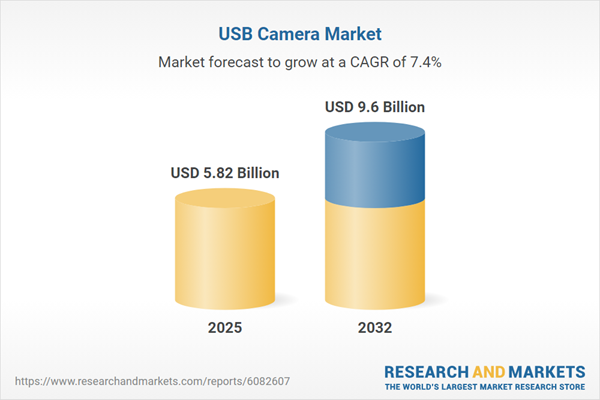Speak directly to the analyst to clarify any post sales queries you may have.
The USB Camera Market is a cornerstone of today’s digitally connected environments, shaping how organizations, educators, and consumers interact and collaborate. Increased demand for intelligent imaging solutions prompts senior decision-makers to stay alert to shifting trends and regulatory drivers that impact procurement, integration, and long-term business value.
Market Snapshot: USB Camera Market Growth and Outlook
The USB camera market expanded from USD 5.41 billion in 2024 to USD 5.82 billion in 2025 and is projected to reach USD 9.60 billion by 2032, registering a CAGR of 7.42%. This growth reflects increased adoption by commercial, educational, and gaming users who now require high-resolution, real-time imaging solutions for seamless interaction. Advances in optics and the introduction of AI-based features boost productivity and collaboration, while broad platform compatibility is crucial for communications and process optimization. The positive trajectory underscores the market's role in business transformation and the enhanced digital experiences now expected by organizations worldwide.
Scope & Segmentation: Exploring the USB Camera Ecosystem
- Applications: Include live streaming for corporate, educational, and gaming settings, as well as surveillance for both commercial and residential security purposes, and advanced video conferencing such as telemedicine.
- End Users: Commercial enterprises, individual consumers, and industrial segments relying on targeted solutions that cater to distinct operational and deployment requirements.
- Interface Types: USB 2.0 supports legacy and budget-friendly uses; USB 3.0 meets professional and higher throughput needs.
- Resolution Choices: 4K UHD, Full HD, HD, and VGA ensure adaptability from specialized tasks to broader compatibility requirements.
- Sensor Technologies: CCD and CMOS sensors offer diverse imaging ranges, with variance in power consumption and cost effectiveness.
- Frame Rates: Options range from up to 30 fps, 30–60 fps, and higher, supporting needs from fast-paced recording to precision capture.
- Price Ranges: Tiered products above USD 100, between USD 50–100, and below USD 50 align with differing budgeting and procurement strategies.
- Distribution Channels: Offline electronics outlets, specialty retail, and online platforms expand access for purchasers across industries.
- Regional Coverage: The Americas, EMEA, and Asia-Pacific are each characterized by regional preferences, deployment trends, and regulatory influences on market adoption.
- Leading Companies: Major competitors are Logitech International S.A., Microsoft Corporation, HP Inc., Lenovo Group Limited, ASUSTeK COMPUTER INC., Razer Inc., Cisco Systems, Inc., GoPro, Inc., Sony Corporation, and Creative Technology Ltd. Each plays a part in fostering innovation and competitive differentiation.
Key Takeaways: Strategic Insights for Senior Decision-Makers
- USB cameras underpin operational efficiency in professional, education, and entertainment sectors, supporting digital-first and hybrid engagement models.
- Manufacturers focus on modularity, easy integration, and energy efficiency to provide scalable solutions that do not compromise visual quality or reliability.
- Advanced sensor technology and machine learning, such as adaptive frame rates and real-time enhancements, are enabling wider applications in areas including healthcare and automation.
- Comprehensive software environments, with SDKs and cloud update capabilities, assist customized solution development, keeping adopters agile in meeting evolving operational demands.
- Market evolution is propelled by strategic alliances, streamlined product development, and holistic integration of software and hardware tailored to diverse user needs.
Tariff Impact: Navigating Economic and Regulatory Pressures
- US-imposed tariffs are increasing operational costs across supply chains, encouraging firms to source from varied geographies and consider local assembly for resilience.
- Changing distribution and pricing structures, such as bundled offerings and flexible agreements, help firms manage cost volatility while sustaining customer satisfaction.
- Collaboration with regulators and automation investments are critical for maintaining operational continuity as companies adapt to global trade fluctuations.
Methodology & Data Sources
This research utilizes robust secondary sources, including annual reports, industry publications, patents, and whitepapers. These are complemented by direct interviews with senior market participants. All segment data is corroborated by data triangulation and thorough statistical checks to ensure reliability.
Why This Report Matters
- Enables executives to align investment and operational priorities with technological and regulatory shifts in the USB camera landscape.
- Provides clear segmentation to guide focused development, marketing, and partnership strategies across regional and user categories.
- Prepares businesses to adapt their supply chains and capture sustained growth potential by anticipating sector and policy developments.
Conclusion
The USB Camera Market’s role in modern business rests on technology progress, adaptable business strategies, and resilient supply systems. Leaders equipped for change and partnership will secure advantages in an evolving digital landscape.
Table of Contents
3. Executive Summary
4. Market Overview
7. Cumulative Impact of Artificial Intelligence 2025
Companies Mentioned
The companies profiled in this USB Camera market report include:- Logitech International S.A.
- Microsoft Corporation
- HP Inc.
- Lenovo Group Limited
- ASUSTeK COMPUTER INC.
- Razer Inc.
- Cisco Systems, Inc.
- GoPro, Inc.
- Sony Corporation
- Creative Technology Ltd
Table Information
| Report Attribute | Details |
|---|---|
| No. of Pages | 181 |
| Published | October 2025 |
| Forecast Period | 2025 - 2032 |
| Estimated Market Value ( USD | $ 5.82 Billion |
| Forecasted Market Value ( USD | $ 9.6 Billion |
| Compound Annual Growth Rate | 7.4% |
| Regions Covered | Global |
| No. of Companies Mentioned | 11 |









